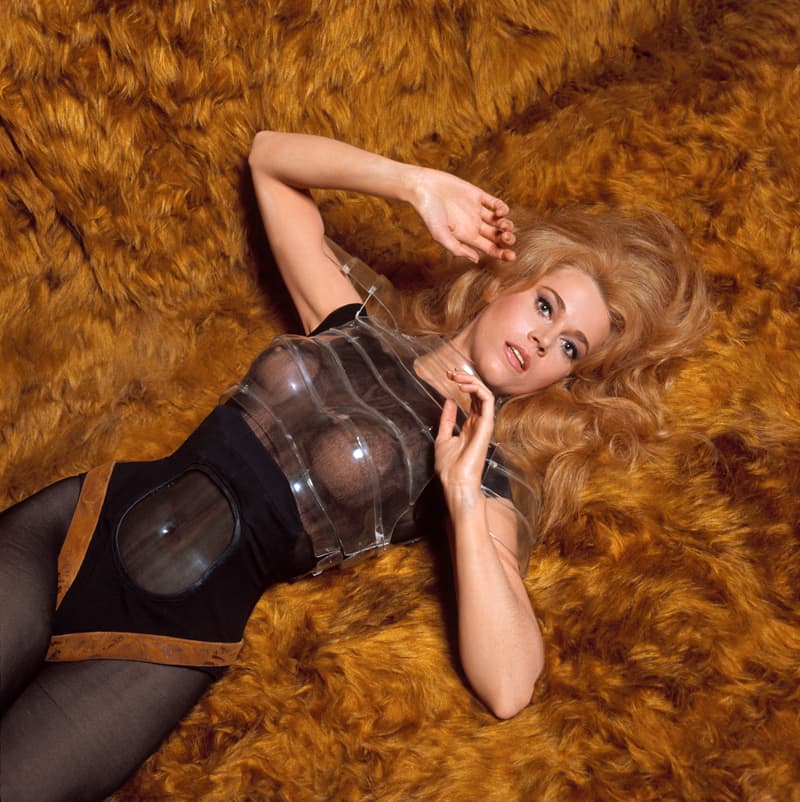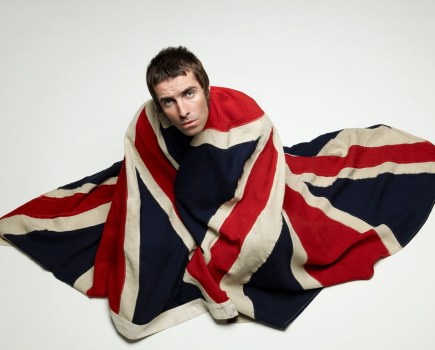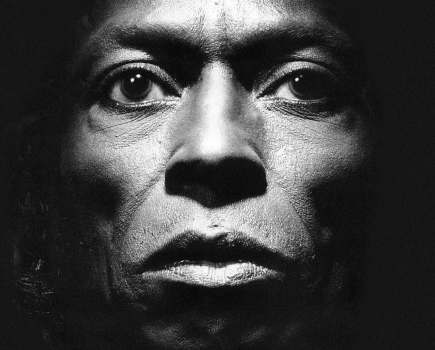Image: Jane Fonda in Barbarella, Rome, 1967 © David Hurn/Magnum Photos
‘Life as it unfolds in front of the camera is full of such complexity, wonder and surprise that I find it unnecessary to create new realities,’ David Hurn once said. ‘There is more pleasure, for me, in things as they are.’ These words effectively sum up the approach that Hurn has maintained throughout his 57-year career, one that has seen him shoot everything from fashion, glamour and film stills to documentary work and reportage.
Hurn’s fascination with photography began while undergoing army officer training at Sandhurst. His father, a career soldier, had reached the rank of major and Hurn also anticipated a military career. However, soon after beginning his training he began to feel uncomfortable with the Cold War propaganda that was part of military life at the time.
He joined the Sandhurst Camera Club and taught himself photography by taking pictures of other cadets. In 1955, he saw photographs of everyday Russian people in Picture Post by Henri Cartier-Bresson. These images, which emphasised the warmth and humanity of ordinary Russians, gave a different view of the ‘enemy’. ‘What I saw in my viewfinder and in published images made me profoundly pacifist,’ he later said.
Hurn resigned from the Army and moved to London, where he got a job selling shirts in Harrods. He soon joined the Reflex photo agency as an assistant and began shooting the early paparazzi-style images of the royal family in which Reflex specialised.
The Hungarian Revolution of 1956 started with mass demonstrations against the Soviet-controlled government. Fascinated by these events, Hurn hitchhiked to Budapest, photographed life in the city during the uprising and the resulting pictures were published in Life and Picture Post. These pictures represented a turning point in his career.
Back in London, Hurn left Reflex and became a freelance photojournalist, supplementing his income with glamour shoots. He got to know the filmmaker Ken Russell and appeared in one of his early documentary films for the BBC, A House in Bayswater (1960). Hurn is shown talking about his work while photographing a naked girl lying in a bath on a rooftop.
In the film he says, ‘The only reason I take pictures of girls is that I have to find some method in which I can earn enough money to live… What I really want to do is to use my camera in the same way as a writer might use a diary. I want to be able to shoot almost by instinct, hoping to bring, in pictures, my own feelings on the event that I see.’

Image: Ladies’ night in David’s local pub in Usk, south-east Wales, 1994 © David Hurn/Magnum Photos
He began shooting a series of documentary projects on subjects such as strippers and drug addicts in London. Many of these photo stories were published in the new Sunday newspaper colour supplements.
He also found work shooting film stills on major productions, including the 1961 epic El Cid, the Bond film From Russia with Love (1963) and the Beatles’ first film A Hard Day’s Night (1964). The most lucrative of these film-related shoots was Barbarella (1968), as Hurn’s pictures of a glamorous semi-clad Jane Fonda were published around the world.
In 1965, Hurn became an associate member of Magnum Photos and the following year photographed the aftermath of the Aberfan disaster in South Wales, when a colliery spoil tip collapsed onto a school, killing 116 children and 28 adults. These pictures brought praise from his hero, Henri Cartier-Bresson.
However, Hurn’s natural inclination was less focused on hard news stories and more on ordinary people in their everyday lives. Hurn returned to live in Wales in 1972 and began photographing the Welsh, documenting their national culture and traditions with humour and insight.
‘I gave myself the task of discovering what was meant by the word culture,’ Hurn told me in an interview in 2009. ‘My way of doing that involved wandering about photographing things I enjoyed and seeing what it all added up to. I realised I was not the least bit interested in being exotic and charging around the world. I had enough problems trying to discover what Wales was about.’
It was to become a long-term project and work carried on well until the 1990s. The resulting book, Wales: Land of My Father, was published in 2000 and it remains his best-known work.
During this period, Hurn also turned his attention towards helping to develop the next generation of documentary photographers. In 1973, he founded the School of Documentary Photography at Gwent College of Higher Education in Newport and became its director.
 His course was practically orientated and focused on the range of skills needed by a documentary photographer, from how to approach and construct a story to analysing potential markets and selling pictures. After 17 years, he retired from full-time teaching in 1990 to return to his own photography.
His course was practically orientated and focused on the range of skills needed by a documentary photographer, from how to approach and construct a story to analysing potential markets and selling pictures. After 17 years, he retired from full-time teaching in 1990 to return to his own photography.
Image: Hurn photographed in 1999 by Josef Koudelka © Josef Koudelka/Magnum Photos
In 1997, Hurn published On Being a Photographer: A Practical Guide, which was written as a dialogue with his long-time friend Bill Jay. He described it as ‘a book on how to think and act like a photographer, culled from practical experience and the lives of many fine photographers of the past and present’. It has become regarded as a classic of its kind.
In 2001, Hurn was diagnosed with cancer of the colon, but successfully battled the illness and made a full recovery. He continues to live and work in his beloved Wales and still photographs virtually every day. He still holds the same belief in what photography can achieve as he did when he began his career.
As he wrote in On Being a Photographer: ‘I believe that in a society in which every individual opinion counts, photography at its best has a unique ability to instruct; to help make alternatives intellectually and emotionally clear; to spotlight foolishness, to bring people together, to break down barriers of prejudice and ignorance and show ideals worth pursuing.’
Further info
Books: David Hurn’s books include On Being a Photographer (co-written with Bill Jay, 1997), Wales: Land of My Father (2000), Living in Wales (2003) and Writing the Picture (with poet John Fuller, 2010).
Websites: More of David Hurn’s images can be seen on the Magnum website, www.magnumphoto.com. The 1960 documentary film featuring Hurn, A House in Bayswater, is available on www.youtube.com. There is also a recently made short documentary film about Hurn’s exhibition Passing Time on www.vimeo.com.
Biography
- 1934: Born in Redhill, Surrey, on 21 July and later educated in Wales
- 1953: Called up for national service in the British Army
- 1955: Begins officer training at Sandhurst. He soon abandons it and begins his photographic career
- 1956: Hitchhikes to Budapest to photograph the revolution in Hungary
- 1961: Spends a year in Spain photographing on the set of the film El Cid. It is the first of several movie-set shoots
- 1964: Hurn shoots movie stills of the Beatles’ film A Hard Day’s Night
- 1965: Becomes an associate member of Magnum Photos and a full member two years later
- 1967: Shoots publicity photos of Jane Fonda in the film Barbarella
- 1973: Sets up the School of Documentary Photography in Newport, Wales
- 1990: Retires from teaching to concentrate on his photographic projects
- 2000: Publication of his best-known book, Wales: Land of My Father
- 2001: Diagnosed with colon cancer, but makes a full recovery
- 2010: A career retrospective exhibition, Passing Time, is held at Cardiff’s Third Floor Gallery







